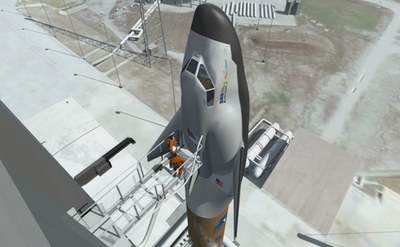Creating near-term results in US human space explorationby S. Alan Stern and Gerry Griffin
|
| We believe that 2021 for the first crewed flight is simply too distant to ensure exploration sustainability, and can therefore ultimately lead us away from the exploration actually intended. |
The reasons for the lack of quicker progress are many, as are those who share the blame. But identifying either those reasons or their culprits isn’t what is most important. What is important, in our estimation, is to avoid the mistakes of the recent past and accelerating progress in order to capture public and political imaginations. More specifically, we believe it is necessary to find a way for human exploration beyond LEO to begin in this very decade.
Unfortunately, the just-announced Space Launch System (SLS)’s first crew flight date goal is 2021, ten years from now. And that’s the best case. We hope the noble goals and intended timetable set by lawmakers and NASA for SLS can be met, but we believe that 2021 for the first crewed flight is simply too distant to ensure exploration sustainability, and can therefore ultimately lead us away from the exploration actually intended.
Since accelerating SLS itself is not fiscally feasible, one is led to ask: What can be done? We believe the solution boils down to one word: Pragmatism. This means exchanging more perfect solutions for more practical ones by using existing systems, modified to the least extent practical, to accelerate the pace of exploration.
We therefore urge an approach that obtains near-term results—i.e., human exploration beyond LEO—as quickly and as pragmatically as possible. In an era when budgets are shrinking, as are both public and political attention spans, we believe this course is a must for human space exploration in the United States.
Specifically what does this course imply? It means two things:
1. Establishing a commercial crew capability to LEO and International Space Station as rapidly as possible, in order to expeditiously free up resources within the human spaceflight budget for exploration, rather than expensive Soyuz seats.
2. Using the savings accrued by adopting commercial crew to jump start human exploration beyond LEO before SLS is ready. This can be accomplished by developing orbital refueling for, and then human-rating, one or more existing rockets to carry out simple exploration missions—such as lunar/near Earth object flybys and orbiters—using the Multi-Purpose Crew Vehicle or other crewed spacecraft that can be ready by mid-decade.
| So let’s accelerate and invigorate human space exploration with human missions launched before this decade is out. |
Studies we—and others—have been involved in over the past 18 months have shown that this kind of pragmatic approach is feasible. We believe that as soon as actual human visits to nearby worlds begin, the public excitement, scientific results, and other benefits of this exploration strengthen the desire for more of it, sustaining both SLS itself and NASA’s exploration objectives set in the 2020s and beyond.
There is no need for us to begin political games. Nor is there a need for new mandates, visions, or elections. But we must find ways to provide nearer-term exploration.
So let’s accelerate and invigorate human space exploration with human missions launched before this decade is out. In doing so, the exploration community can achieve the sustainability that has eluded us so far, and show a nation and the world just how creative and productive Americans of this generation can be in human space exploration.
